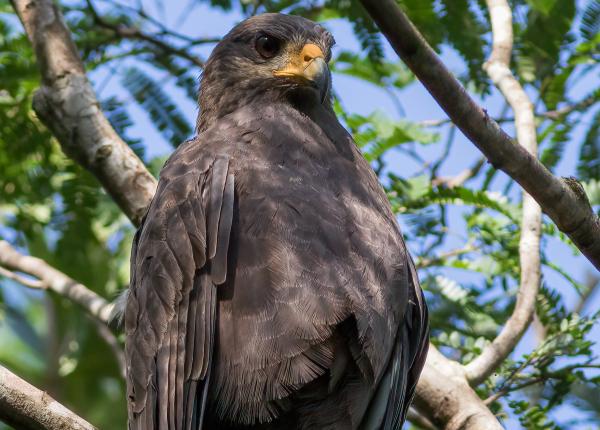Did You Know?
- In Cuba, the Cuban Black Hawk is categorized as Endangered
- Scientists estimate that over the past 100 years, the Cuban Black Hawk has lost around 50% of its habitat
How The Peregrine Fund is Helping
Though The Peregrine Fund does not work directly with Cuban Black Hawks, our efforts in scientific research, habitat conservation, education, and community development help conserve raptors around the world. We also supply literature to researchers from our avian research library, which helps scientists the world over gather and share important information on raptor conservation.
Where They Live
The Cuban Black Hawk is endemic to the island of Cuba. It mostly is found along the coastlines near swamps and mangroves, in palm savanna and along roadsides.
What They Do
As its name suggests, the Cuban Black Hawk is draped almost completely in black feathers from head to tail. However, if you take a closer look at this lovely bird, you will certainly notice the subtle splashes of color that adorn its body. The females have a slightly brownish tone to their back. Both adults have a bright white band across their otherwise dark tail, and have bright yellow legs and a yellow cere. They also have an off-white malar stripe, In flight, an intricate pattern of whites, grays, and browns decorate this bird's underwings.
The Cuban Black Hawk is a diurnal bird of prey that does not migrate.
Why They Need Our Help
Birdlife International categorizes the Cuban Black Hawk as a species that is Near Threatened. Of course, just the fact that its entire population is limited to islands makes it even more vulnerable to threats. It had a relatively small range to begin with. But now, due to the destruction of its wetland habitat, there are fewer and fewer places for this hawk to live.
What They Eat
The Cuban Black Hawk feeds on a number of different species. A high portion of its diet includes crabs, but it also feeds on centipedes, lizards, birds, and rats. One researcher observed this hawk drowning a Common Moorhen (Gallinula chloropus), which is an unusual prey item and could be an unusual behavior for this species as well.
Nests, Eggs and Young
Cuban Black Hawks breed from January through June. They build nests that are large cup-shaped structures made of mangrove twigs, placed 3.5-8 m high in the canopy. The nests are lined with green leaves and sprigs. The females can lay 1-2 eggs, which are dull grayish-white. There is still so much to learn about the breeding habitats of this amazing hawk. It would be an excellent species to study for any biologist!
Cuban Black Hawks and World Center for Birds of Prey
The World Center for Birds of Prey offers fun ways to learn about birds of prey. Interactive activities, tours, interesting videos and a children's room with activities from coloring sheets to quizzes to costumes await you. At our visitor center, you can see many hawks up close and learn about the wonderful and interesting adaptations they have in order to survive in their respective habitats. "Pheonix" our resident Red-tailed Hawk, and "Griffon" the Swainson's Hawk are two hawk species that call the World Center for Birds of Prey home.
References:
del Hoyo, J., N. Collar, J. S. Marks, and C. J. Sharpe (2020). Cuban Black Hawk (Buteogallus gundlachii), version 1.0. In Birds of the World (J. del Hoyo, A. Elliott, J. Sargatal, D. A. Christie, and E. de Juana, Editors). Cornell Lab of Ornithology, Ithaca, NY, USA. https://doi.org/10.2173/bow.cubblh1.01
Global Raptor Information Network. 2021. Species account: Cuban Black Hawk Buteogallus gundlachii. Downloaded from http://www.globalraptors.org on 12 Feb. 2021









